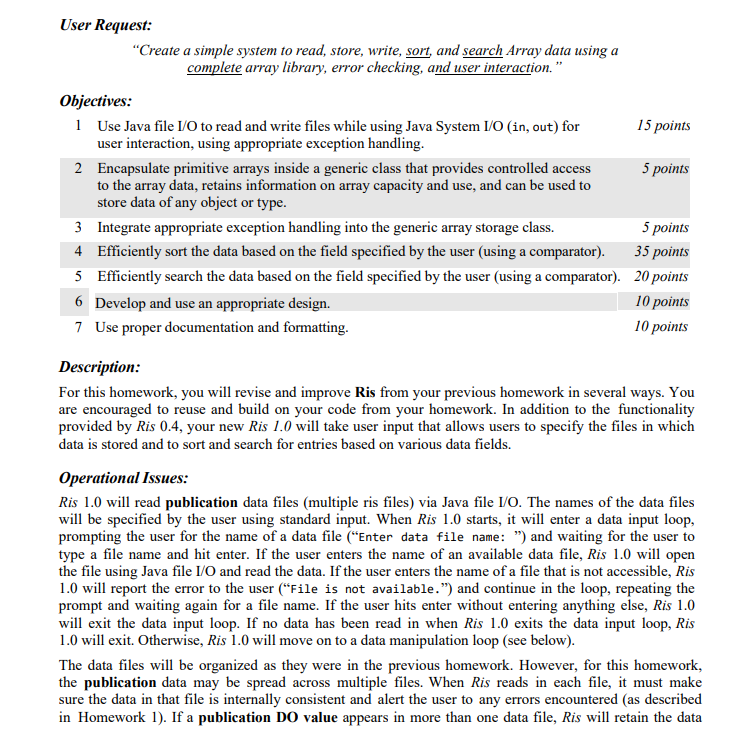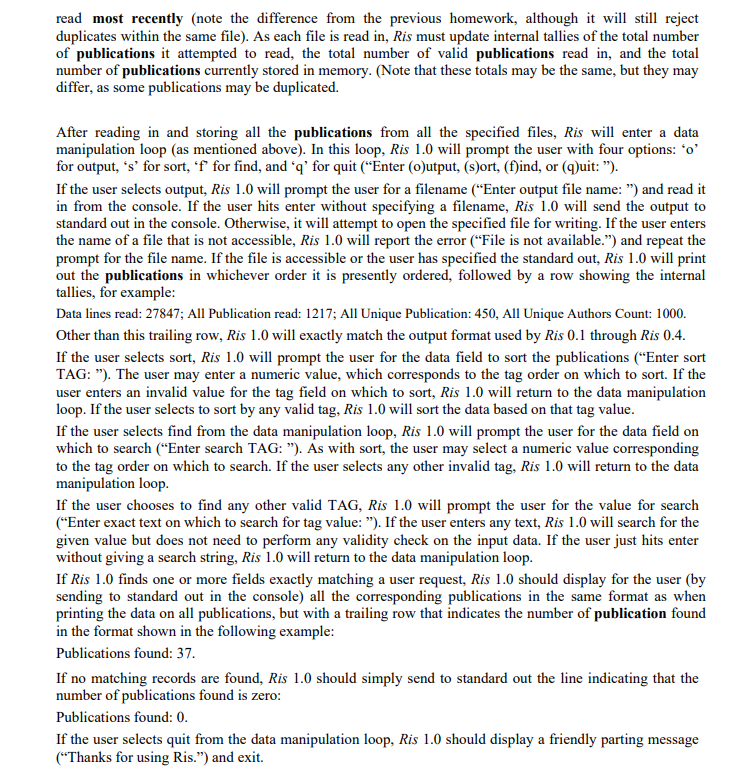Answered step by step
Verified Expert Solution
Question
1 Approved Answer
Convert the information into a Java Program, specifically Eclipse, but provide a working source code if possible! User Request: Create a simple system to read,


Convert the information into a Java Program, specifically Eclipse, but provide a working source code if possible!
User Request: "Create a simple system to read, store, write, sort, and search Array data using a complete array library, error checking, and user interaction. " Description: For this homework, you will revise and improve Ris from your previous homework in several ways. You are encouraged to reuse and build on your code from your homework. In addition to the functionality provided by Ris 0.4 , your new Ris 1.0 will take user input that allows users to specify the files in which data is stored and to sort and search for entries based on various data fields. Operational Issues: Ris 1.0 will read publication data files (multiple ris files) via Java file I/O. The names of the data files will be specified by the user using standard input. When Ris 1.0 starts, it will enter a data input loop, prompting the user for the name of a data file ("Enter data file name: ") and waiting for the user to type a file name and hit enter. If the user enters the name of an available data file, Ris 1.0 will open the file using Java file I/O and read the data. If the user enters the name of a file that is not accessible, Ris 1.0 will report the error to the user ("File is not available.") and continue in the loop, repeating the prompt and waiting again for a file name. If the user hits enter without entering anything else, Ris 1.0 will exit the data input loop. If no data has been read in when Ris 1.0 exits the data input loop, Ris 1.0 will exit. Otherwise, Ris 1.0 will move on to a data manipulation loop (see below). The data files will be organized as they were in the previous homework. However, for this homework, the publication data may be spread across multiple files. When Ris reads in each file, it must make sure the data in that file is internally consistent and alert the user to any errors encountered (as described in Homework 1). If a publication DO value appears in more than one data file, Ris will retain the data read most recently (note the difference from the previous homework, although it will still reject duplicates within the same file). As each file is read in, Ris must update internal tallies of the total number of publications it attempted to read, the total number of valid publications read in, and the total number of publications currently stored in memory. (Note that these totals may be the same, but they may differ, as some publications may be duplicated. After reading in and storing all the publications from all the specified files, Ris will enter a data manipulation loop (as mentioned above). In this loop, Ris 1.0 will prompt the user with four options: 'o' for output, 's' for sort, ' f ' for find, and ' q ' for quit ("Enter (o)utput, (s)ort, (f)ind, or (q)uit: "). If the user selects output, Ris 1.0 will prompt the user for a filename ("Enter output file name: ") and read it in from the console. If the user hits enter without specifying a filename, Ris 1.0 will send the output to standard out in the console. Otherwise, it will attempt to open the specified file for writing. If the user enters the name of a file that is not accessible, Ris 1.0 will report the error ("File is not available.") and repeat the prompt for the file name. If the file is accessible or the user has specified the standard out, Ris 1.0 will print out the publications in whichever order it is presently ordered, followed by a row showing the internal tallies, for example: Data lines read: 27847; All Publication read: 1217; All Unique Publication: 450, All Unique Authors Count: 1000. Other than this trailing row, Ris 1.0 will exactly match the output format used by Ris 0.1 through Ris 0.4 . If the user selects sort, Ris 1.0 will prompt the user for the data field to sort the publications ("Enter sort TAG: "). The user may enter a numeric value, which corresponds to the tag order on which to sort. If the user enters an invalid value for the tag field on which to sort, Ris 1.0 will return to the data manipulation loop. If the user selects to sort by any valid tag, Ris 1.0 will sort the data based on that tag value. If the user selects find from the data manipulation loop, Ris 1.0 will prompt the user for the data field on which to search ("Enter search TAG: "). As with sort, the user may select a numeric value corresponding to the tag order on which to search. If the user selects any other invalid tag, Ris 1.0 will return to the data manipulation loop. If the user chooses to find any other valid TAG, Ris 1.0 will prompt the user for the value for search ("Enter exact text on which to search for tag value: "). If the user enters any text, Ris 1.0 will search for the given value but does not need to perform any validity check on the input data. If the user just hits enter without giving a search string, Ris 1.0 will return to the data manipulation loop. If Ris 1.0 finds one or more fields exactly matching a user request, Ris 1.0 should display for the user (by sending to standard out in the console) all the corresponding publications in the same format as when printing the data on all publications, but with a trailing row that indicates the number of publication found in the format shown in the following example: Publications found: 37. If no matching records are found, Ris 1.0 should simply send to standard out the line indicating that the number of publications found is zero: Publications found: 0 . If the user selects quit from the data manipulation loop, Ris 1.0 should display a friendly parting message ("Thanks for using Ris.") and exitStep by Step Solution
There are 3 Steps involved in it
Step: 1

Get Instant Access to Expert-Tailored Solutions
See step-by-step solutions with expert insights and AI powered tools for academic success
Step: 2

Step: 3

Ace Your Homework with AI
Get the answers you need in no time with our AI-driven, step-by-step assistance
Get Started


